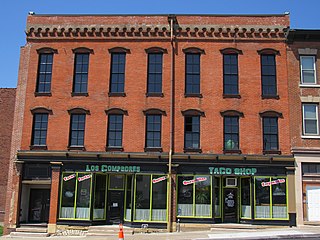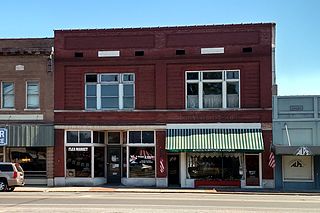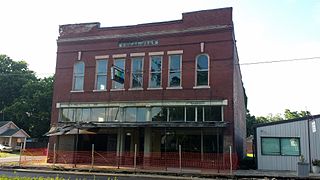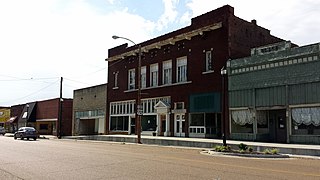
The Bank Building was a historic commercial building located at 40-44 South Street, in Uxbridge, Massachusetts. Until its destruction by fire in 2013, it was the best-preserved of Uxbridge's 19th century commercial buildings. It was built in 1895–96, and was listed on the National Register of Historic Places in 1983.

The Taylor Building is a historic commercial building at 304 Main Street in Little Rock, Arkansas. It is a three-story masonry structure, built out of load-bearing brick with limestone trim. Its facade has a commercial storefront on the ground floor, and three windows on the upper floors, articulated by two-story columns rising to limestone capitals and finely crafted Romanesque arches. Built in 1897, it is a rare surviving example of 19th-century commercial architecture in the city.

The Governor's Mansion Historic District is a historic district covering a large historic neighborhood of Little Rock, Arkansas. It was listed on the National Register of Historic Places in 1978 and its borders were increased in 1988 and again in 2002. The district is notable for the large number of well-preserved late 19th and early 20th-century houses, and includes a major cross-section of residential architecture designed by the noted Little Rock architect Charles L. Thompson. It is the oldest city neighborhood to retain its residential character.

The Masonic Temple Building is a historic Prairie-style building in Oak Park, Illinois, at the corner of Oak Park Avenue and Lake Street. It is in the Ridgeland-Oak Park Historic District and was individually listed on the National Register of Historic Places in 1982.

The Wupperman Block/I.O.O.F. Hall is a historic building located just north of downtown Davenport, Iowa, United States. It was individually listed on the National Register of Historic Places in 1983. In 2020 it was included as a contributing property in the Davenport Downtown Commercial Historic District.

The Joe P. Eagle and D. R. Boone Building is a historic commercial building at 105-107 West Front Street in downtown Lonoke, Arkansas. It is a two-story red brick building, with a sloping flat roof obscured by parapet, and a brick foundation. It is divided into two sections, articulated by brick pilasters. The left half has an original storefront on the first floor, with plate glass display windows flanking a recessed entrance, while the right half has a more modern (1960s) appearance, with a central display window, with the store entrance on the right and a building entrance to the upper floor on the left. The second-floor on both halves has tripled sash windows, the center one larger, all topped by transom windows. The building was designed by architect Charles L. Thompson and built in 1905.

The Frauenthal & Schwarz Building, also known as the Front Street Mall. is a historic commercial building at 824 Front Street in Conway, Arkansas. It was designed by architects Sanders & Ginocchio and built in 1925 as a major expansion and renovation of an 1879 building. It is a two-story structure, built of brick, steel, and concrete. Its ground floor storefront consists of plate glass windows and two double-leaf doorways, sheltered by a flat metal overhang. The upper floor has four groups of six windows, each consisting of larger-paned sections topped by smaller-paned ones. A decorative cornice with Mediterranean touches and flattened Italianate brackets extends above them. The building is one of the city's architecturally finest surviving commercial structures of the 1920s, designed by a prominent firm.

The John Tushek Building is a historic commercial building at 108 Main Street in Lake Village, Arkansas. The two story brick building was built in 1906 by John Tushek, an Austro-Hungarian immigrant who ran a mercantile store on the premises. The building has vernacular Beaux Arts styling popular at the time, presenting facades to both Main and Court Streets. The ground floors of these facades are divided into storefronts with large glass windows, with access to the upper floor offices via an entrance on the corner. The second floor windows are capped with decorative metal crowns, and topped by small oculus windows. The facade is topped by a corbelled brick cornice and parapet.

The Hayes Hardware Store is a historic commercial building at 314 DeQueen Street in downtown De Queen, Arkansas. It is a brick 1-1/2 story structure, sharing party walls with adjoining buildings on either side. Its brick facade is divided into two three-bay sections, with brick pilasters at the ends and in the center. Above the first-floor storefront windows is a clerestory level, above which is an attic space, where each of the six bays has a small oculus window. Above the second and fifth bays is a rounded arch. The building was built c. 1900 by the Dierks Lumber and Coal Company, which built the De Queen and Eastern Railroad, making the city the commercial center of Sevier County. The building was acquired in 1908 by the Hayes Hardware Company.

The Dabbs Store is a historic retail building at 1320 South Avalon Street in West Memphis, Arkansas. It is a brick two-story structure, located near the railroad tracks and the site of a now-demolished train depot in an isolated area of West Memphis. The building has two storefronts and a central entrance leading to the upper floor, which houses residential spaces. The storefronts are similarly styled but differ in size, that on the left wider due to larger windows flanking its entrance. The windows of the storefronts are mounted on decorative wooden panels, and there are a series of large transom windows above the porch roof, matching the width of each storefront. Built in 1912, it is one of the oldest surviving commercial structures in the city.

The Henry Furniture Store Building is a historic commercial building at 107 West University in Siloam Springs, Arkansas. It is a single-story brick building, with an angled recessed storefront topped by a raised brick parapet set above brick corbelling and a pressed metal cornice. Built c. 1900, it is the best example in the city of commercial architecture from that time period.

The Pinkston–Mays Store Building is a historic commercial building at 107-109 Lackston Street in Lowell, Arkansas. It is a two-story brick building with a flat roof, and is divided into two storefronts, separated by a stairway leading to the second floor. The two storefronts are arranged identically, with a central entrance flanked by fixed glass windows. The elements of the first floor facade are separated by brick pilaster, and the storefronts are highlighted by brick corbelling above. Built in 1902, the building is a little-altered local example of early 20th century commercial architecture.

The Bondi Brothers Store is a historic commercial building at 104 Madison Street in downtown Clarendon, Arkansas. It is a two-story brick building, with modest Italianate styling. Its storefront has been altered to have plate glass over much of the front, but the recessed entrance remains, with an original transom window. The store was built in 1904 by Ike and Ed Bondi, sons of German immigrants who established a successful clothing store.

The Treat Commercial Building is a historic commercial building on Oak Street, between High and 4th Streets, in Leslie, Arkansas. It is a single-story brick structure, with a vernacular early-20th century storefront and sharing party walls with its neighbors. The front has a pair of plate glass windows flanking a recessed entrance, and is topped by a parapet. The interior retains original fixtures and a coffered pressed-metal ceiling. Built in 1910, it is one of Leslie's oldest commercial buildings.

The Wade Building is a historic commercial building located at 231 Central Avenue in Hot Springs, Arkansas.

Kocourek and Son Hardware is a historic commercial building at 110 East North Front Street in Hazen, Arkansas. It is a two-story brick structure, with commercial Italianate styling typical of the early 20th century. It has two storefronts, each with plate glass display windows and recessed entrances, on the ground floor, and four pairs of sash windows on the second, set in segmented-arch openings. Above this are two bands of brick corbelling, with four brick panels articulated by pilasters, each panel with a wrought iron grill at the center. It house the named hardware store from its construction until 2002, and is the city's finest example of early 20th-century commercial architecture.

The Monroe County Bank Building is a historic commercial building at 225-227 West Cypress Street in Brinkley, Arkansas. It is a two-story brick building, with brick and stone trim elements. It houses three storefronts on the ground floor, with professional offices and other spaces on the upper floor. It was built about 1889, and its facade was redone in 1909 after suffering extensive damage caused by a tornado. The Monroe County Bank, for whom it was built, was the town's first major bank, and occupied the building until the 1930s. Its upper level also housed the town's largest performance venue of the time.

The T.E. Olmstead & Son Funeral Home is a historic commercial building at 108 South Fourth Street in Heber Springs, Arkansas. It is a single-story stone structure, with a parapeted sloping roof. It has a single storefront, with a recessed entry flanked by plate glass display windows. Built in 1910, it is the city's only funeral home, and one of its early stone commercial buildings.

The Zeb Ward Building is a historic commercial building located at 1001–1003 West Markham Street in Little Rock, Arkansas. It is a two-story masonry structure, with cast iron storefront surrounds and otherwise brick construction. The building has vernacular commercial Italianate style, with narrow windows at the upper level set in segmented-arch and round-arch openings with brick headers. Its front facade is topped by a stepped parapet. It was built in 1881 by Zeb Ward, and was probably built by prison labor, with its bricks fabricated in the prison yard. Zeb Ward was at the time of its construction the lessee and operator of the Arkansas State Penitentiary.

The Merrero Building is a historic building located in Maquoketa, Iowa, United States. It was built in 1918 to replace a three-story brick building on the same location that was damaged in a fire the previous year. While there was a debate about whether to rebuild or build new, it appears they built a new building. It is a two-story structure with three storefronts on the main level. It is significant as an example of early 20th-century commercial design and material. The exterior is composed of white glazed brick with paired windows on the second floor. An old fashioned Italianate metal cornice caps the main facade. While it looks out of place, historic photos show that it is part of the original design. Marble panels were originally located below the display windows on the main floor. The storefront on the left has been altered, but the other two are originals. Transoms above the second floor windows, and the prism glass transoms above the storefronts remain in place, but have been covered. The building was listed on the National Register of Historic Places in 1991.





















